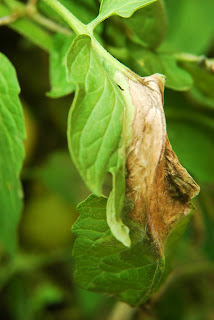 My buckwheat/crimson clover summer cover crop has sprung up nicely, but the fast-growing buckwheat is definitely dominating the mixture. Last summer my lab mate found that mowing down the buckwheat in a mix like this gives the clover the light it needs to really get growing (and hopefully for the next crop, fixing lots of nitrogen).
My buckwheat/crimson clover summer cover crop has sprung up nicely, but the fast-growing buckwheat is definitely dominating the mixture. Last summer my lab mate found that mowing down the buckwheat in a mix like this gives the clover the light it needs to really get growing (and hopefully for the next crop, fixing lots of nitrogen). Since this is a garden and not a whole field (and because I don't have a tractor anyway), I just went at the buckwheat with a pair of scissors to give the clover some light.
Since this is a garden and not a whole field (and because I don't have a tractor anyway), I just went at the buckwheat with a pair of scissors to give the clover some light. Beets seem to be doing OK.
Beets seem to be doing OK.This year most of the Northeast was hit early and hit hard by late blight, a plant disease caused by the infamous Phytophthora infestans oomycete. The disease affects potatoes and tomatoes (Learn about late blight at: http://vegetablemdonline.ppath.cornell.edu/factsheets/Potato_LateBlt.htm). This year's early infection can be attributed to sales of diseased tomato plants from many of the "big box" stores like Wal-mart, Lowe's, and Home Depot (see NY Times article at: http://www.nytimes.com/2009/07/18/nyregion/18tomatoes.html?_r=1). Since the spores can be spread by wind on cloudy days, and because we've had so much rain (great growing and spore-producing conditions) the infected plants spread the disease to gardens and farms that had clean transplants to start with.
So, the moral of this story is: (1) Big box stores that do not even know how to identify diseased plants should not be allowed to sell transplants! And (2) Since (1) is unlikely, please buy your garden transplants from local farmers who know late blight when they see it and are smart enough not to pass it on!
So, the moral of this story is: (1) Big box stores that do not even know how to identify diseased plants should not be allowed to sell transplants! And (2) Since (1) is unlikely, please buy your garden transplants from local farmers who know late blight when they see it and are smart enough not to pass it on!
 This is a tomato leaf in the early stages of infection with late blight, with brown spots on the lower leaves (above and following picture).
This is a tomato leaf in the early stages of infection with late blight, with brown spots on the lower leaves (above and following picture).
 These plants are further along in the infection stage, with most of the leaves rotted (above and following picture). The Sungolds have mostly been OK, with the tomatoes ripening mainly clean, more than 20 per day for the past 2 weeks. Unfortunately, most of my big tomatoes (Pink Beauty and Brandywine) have been infected by the blight and I've had to throw them out. :-( It was a bummer to lose tomatoes sizing up so nicely, but I really feel bad for the farmers who have invested so much in their tomato crops and were depending on the income.
These plants are further along in the infection stage, with most of the leaves rotted (above and following picture). The Sungolds have mostly been OK, with the tomatoes ripening mainly clean, more than 20 per day for the past 2 weeks. Unfortunately, most of my big tomatoes (Pink Beauty and Brandywine) have been infected by the blight and I've had to throw them out. :-( It was a bummer to lose tomatoes sizing up so nicely, but I really feel bad for the farmers who have invested so much in their tomato crops and were depending on the income.










































